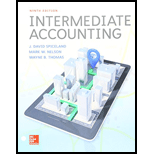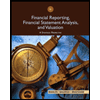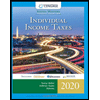
Multiple differences; temporary difference yet to originate; multiple tax rates
• LO16–5, LO16–6
You are the new
1. Pretax accounting income was $41 million and taxable income was $8 million for the year ended December 31, 2018.
2. The difference was due to three items:
a. Tax depreciation exceeds book depreciation by $30 million in 2018 for the business complex acquired that year. This amount is scheduled to be $60 million in 2019 and to reverse as ($50 million) and ($40 million) in 2020 and 2021, respectively.
b. Insurance of $9 million was paid in 2018 for 2019 coverage.
c. A $6 million loss contingency was accrued in 2018, to be paid in 2018.
3. No temporary differences existed at the beginning of 2018.
4. The tax rate is 40%.
Required:
1. Determine the amounts necessary to record income taxes for 2018, and prepare the appropriate
2. Assume the enacted federal income tax law specifies that the tax rate will change from 40% to 35% in 2020. When scheduling the reversal of the depreciation difference, you were uncertain as to how to deal with the fact that the difference will continue to originate in 2019 before reversing the next two years. Upon consulting PricewaterhouseCoopers’ Comperio database, you found:
.441
Only the reversals of the temporary difference at the
You interpret that to mean, when future taxable amounts are being scheduled, and a portion of a temporary difference has yet to originate, only the reversals of the temporary difference at the balance sheet date can be scheduled and multiplied by the tax rate that will be in effect when the difference reverses. Future originations (like the depreciation difference the second year) are not considered when determining the timing of the reversal. For the existing temporary difference, it is assumed that the difference will reverse the first year the difference begins reversing.
Determine the amounts necessary to record income taxes for 2018, and prepare the appropriate journal entry.
1.
Temporary Difference
Temporary difference refers to the difference of one income recognized by the tax rules and accounting rules of a company in different periods. Consequently, the difference between the amount of assets and liabilities reported in the financial reports and the amount of assets and liabilities as per the company’s tax records, is known as temporary difference.
Multiple Temporary Difference
It is very unlikely to have a single temporary difference in any company. In that case, the same concept of temporary difference will be applicable for multiple temporary difference. In case of multiple temporary difference, we have to categorize all temporary difference into future taxable amount and future deductible amounts. The total amount of future taxable amounts multiplied by future tax rate will generate deferred tax liability and total amount of future deductible amount multiplied by future tax rate will generate deferred tax asset.
To prepare: The appropriate journal entry to record the income taxes.
Explanation of Solution
The journal entry to record the income taxes in the books is as follows:
| Date | Account Titles and Explanation | Post Ref. | Debit ($) (in millions) |
Credit ($) (in millions) |
|
| 2018 | |||||
| Income Tax Expense (4) | 16.4 | ||||
| Deferred Tax Asset (2) | 2.4 | ||||
| Deferred Tax Liability (1) | 15.6 | ||||
| Income Tax Payable (3) | 3.2 | ||||
| (To record income taxes) | |||||
Table (1)
Working Notes:
Calculate the value of deferred tax liability
Calculate the value of deferred tax asset
Calculate the value of income tax payable
Calculate the value of income tax expenses
- Income Tax Expense is an expense account and it decreases the value of shareholders’ equity account. So, debit Income Tax Expense account with $16.4 million.
- Deferred tax asset is an asset and is increased by $2.4 million. Therefore, debit deferred tax asset account with $2.4 million.
- Deferred tax liability is a liability and is increased by $15.6 million. Therefore, credit deferred tax liability account with $15.6 million.
- Income Tax Payable is a liability account has increased because the taxable income has increased. So, credit Income Tax Payable account with $3.2 million.
2.
Explanation of Solution
Determine the amounts necessary to record income taxes for 2018
| Current Year | Future Taxable (Deductible) Amounts | Deferred Tax | ||||
| 2018 | 2019 | 2020 | 2021 | Liability | Asset | |
| Pretax accounting income | 41 | |||||
| Temporary Differences: | ||||||
| Depreciation | (30) | 30 | ||||
| Prepaid Insurance | (9) | 9 | ||||
| Future Tax rate | 40% | 35% | ||||
| Deferred tax liability | 3.6 | 10.5 | 14.1 | |||
| Loss Contingency | 6 | (6) | ||||
| Future Tax rate | 35% | |||||
| Deferred tax asset | 2.1 | (2.1) |
||||
| Taxable Income | 8 | |||||
| Tax rate | 40% | |||||
| Income Tax payable | 3.2 (5) | |||||
Table (2)
Compute deferred tax asset and deferred tax liability amount
Deferred tax liability (in million) |
Deferred tax assets (in million) |
|
| Ending balance (current balance needed) | $14.1 | $2.1 |
| Less: Beginning balance | $0 | $0 |
| Change needed to achieve desired balance | $14.1 (6) | $2.1 (7) |
Table (3)
Calculate the value of income tax expenses
The journal entry to record the income taxes at the end of 2018 is as follows:
| Date | Account Titles and Explanation | Post Ref. | Debit ($) (in millions) |
Credit ($) (in millions) |
|
| 2018 | |||||
| Income Tax Expense (8) | 15.2 | ||||
| Deferred Tax Asset (7) | 2.1 | ||||
| Deferred Tax Liability (6) | 14.1 | ||||
| Income Tax Payable (5) | 3.2 | ||||
| (To record income taxes) | |||||
Table (4)
- Income Tax Expense is an expense account and it decreases the value of shareholders’ equity account. So, debit Income Tax Expense account with $15.2 million.
- Deferred tax asset is an asset and is increased by $2.1 million. Therefore, debit deferred tax asset account with $2.1 million.
- Deferred tax liability is a liability and is increased by $14.1 million. Therefore, credit deferred tax liability account with $14.1 million.
- Income Tax Payable is a liability account has increased because the taxable income has increased. So, credit Income Tax Payable account with $3.2 million.
Note:
When a portion of temporary difference is yet to generate in future period, we have to consider only the reversals of temporary difference at balance sheet date e.g., $ 30 for depreciation. Future temporary difference of depreciation has not taken into consideration. We assume that existing difference reverses in the first year after the difference no longer is originating (in this case year 2020). If we consider future originations of temporary difference then the deferred tax liability would be $7.5 million instead of $10.5 million.
| Current Year | Future Taxable (Deductible) Amounts | Total | |||
| 2018 | 2019 | 2020 | 2021 | ||
| Depreciation | (30) | (60) | 50 | 40 | |
| Future Tax rate | 40% | 35% | 35% | ||
| Deferred tax liability | (24) | 17.5 | 14 | 7.5 | |
Table (5)
Want to see more full solutions like this?
Chapter 16 Solutions
GEN COMBO LOOSELEAF INTERMEDIATE ACCOUNTING; CONNECT ACCESS CARD
- I need help with this general accounting question using standard accounting techniques.arrow_forwardCurrent Attempt in Progress The following transactions involving intangible assets of Oriole Corporation occurred on or near December 31, 2025. 1. 2. Oriole paid Grand Company $520,000 for the exclusive right to market a particular product, using the Grand name and logo in promotional material. The franchise runs for as long as Oriole is in business. Oriole spent $654,000 developing a new manufacturing process. It has applied for a patent, and it believes that its application will be successful. 3. 4. 5. 6. In January 2026, Oriole's application for a patent (#2 above) was granted. Legal and registration costs incurred were $247,800. The patent runs for 20 years. The manufacturing process will be useful to Oriole for 10 years. Oriole incurred $168,000 in successfully defending one of its patents in an infringement suit. The patent expires during December 2029. Oriole incurred $446,400 in an unsuccessful patent defense. As a result of the adverse verdict, the patent, with a remaining…arrow_forwardPlease explain the solution to this general accounting problem with accurate explanations.arrow_forward
- I am searching for the correct answer to this general accounting problem with proper accounting rules.arrow_forwardCan you solve this general accounting problem using accurate calculation methods?arrow_forwardI need help with this general accounting question using standard accounting techniques.arrow_forward
- Please explain the solution to this general accounting problem with accurate explanations.arrow_forwardI need help with this general accounting problem using proper accounting guidelines.arrow_forwardI am trying to find the accurate solution to this general accounting problem with appropriate explanations.arrow_forward
- I am searching for the correct answer to this general accounting problem with proper accounting rules.arrow_forwardI am trying to find the accurate solution to this general accounting problem with the correct explanation.arrow_forwardPlease provide the answer to this general accounting question using the right approach.arrow_forward
 Financial Reporting, Financial Statement Analysis...FinanceISBN:9781285190907Author:James M. Wahlen, Stephen P. Baginski, Mark BradshawPublisher:Cengage Learning
Financial Reporting, Financial Statement Analysis...FinanceISBN:9781285190907Author:James M. Wahlen, Stephen P. Baginski, Mark BradshawPublisher:Cengage Learning Individual Income TaxesAccountingISBN:9780357109731Author:HoffmanPublisher:CENGAGE LEARNING - CONSIGNMENT
Individual Income TaxesAccountingISBN:9780357109731Author:HoffmanPublisher:CENGAGE LEARNING - CONSIGNMENT





